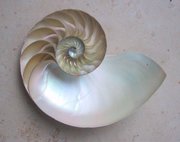Nautilus
|
|
- For other uses, see Nautilus (disambiguation).
| Nautilus | ||||||||||||||||
|---|---|---|---|---|---|---|---|---|---|---|---|---|---|---|---|---|
| Missing image Natilus_1_bg_022402.jpg A living nautilus A nautilus | ||||||||||||||||
| Scientific classification | ||||||||||||||||
| ||||||||||||||||
| Species | ||||||||||||||||
|
Allonautilus perforatus |
The nautilus is a marine creature of the class Cephalopoda. The five nautilus species are the sole living members of the Nautiloidea subclass in the order Nautilida. Nautilus is also the name of one of the two genera in the Nautilidae family. Allonautilus is the other genus and is very similar to Nautilus. They are found only in the western Pacific, inhabiting waters around coral reefs. The species has survived relatively unchanged for millions of years, much like the Coelacanth.
Its name comes from the Greek nautilos, which means "sailor". The name originally referred to the Argonauta, otherwise called the "paper nautilus", because it was alleged to use its two disk-bearing arms as sails (cf. Aristotle Historia Animalium 622b).
The nautilus is similar in general form to other cephalopods, with a prominent head and undifferentiated tentacles. Nautiluses have up to ninety tentacles, although without suckers. Unlike the other living members of the class, the bony structure of the body is externalised as a shell, providing protection and buoyancy. The nautilus can withdraw completely into its shell, closing the opening with a leathery hood that is formed from two specially folded tentacles.
The shell is calcareous and internally divided into chambers; this section of the shell is known as a phragmocone. The phragmocone is divided by septa (sing. septum) and are all pierced by a tube, the siphuncle. The chambers making up the phragmocone are called camerae (sing. camera). The last fully open chamber is the living chamber. As the nautilus matures its body moves forward, sealing the camera behind it with a new septum. Adults can have thirty or more camerae to their shells. Buoyancy is generally maintained as neutral, but it can be controlled by gas and fluid being pumped into or from the camerae by an osmotic process along the siphuncle. The control of buoyancy in this manner limits the nautilus; they cannot operate under extreme hydrostatic pressures. In the wild nautiluses usually inhabit depths of about 600–800 m, rising to around 200 m at night for feeding, mating and egg laying.
Like other cephalopods, nautiluses swim by jet action using a fold in the mantle called a hyponome, and by pistoning water by head movements into and out of the living chamber. They are predators and feed mainly on shrimp and other small sea-life.
Unlike other cephalopods they do not have good vision. Their eye structure is highly developed but lacks a solid lens. They have a simple "pinhole" lens through which water can pass.
Nautiluses are sexually dimorphic and reproduce by laying eggs. Attached to rocks in shallower waters, the eggs take twelve months to develop before hatching out at around 30 mm long. The largest adults are no more than 300 mm in diameter.
The spiral seen in a cutaway Nautilus shell (see image above) is one of the most perfect logarithmic spirals found in nature. It is often claimed to be related to the Golden ratio, but this claim is unsubstantiated.
Camouflage
The shell of the nautilus has evolved to make it as invisible as possible in the water. From the top looking down, the shell coloration blends in with the bottom or darkness below. When viewed from underneath, the shell is almost completely white, blending in with the light from above. Template:-
Classification
Nautilus_shell.jpg
Fossil records indicate that the nautiloids were much more extensive and varied in the past. Many were initially straight-shelled, as in the extinct genus Lituites. They developed in the Cambrian period and became a significant sea predator in the Ordovician period. Certain species reached over 2.5 meters in size. The other cephalopod subclass, Coleoidea, diverged from the Nautilidae over 400 million years ago and the nautilus has remained relatively unchanged since that time. Extinct relatives of the nautilus include ammonites, such as the Baculites and Goniatites.
- CLASS CEPHALOPODA
- Subclass Nautiloidea: modern and ancient nautiluses
- Order Nautilida: modern nautiluses
- Family Nautilidae
- Allonautilus perforatus
- Crusty Nautilus, Allonautilus scrobiculatus
- Palau Nautilus, Nautilus belauensis
- Bellybutton Nautilus, Nautilus macromphalus
- Nautilus pompilius
- Emperor Nautilus, Nautilus pompilius pompilius
- Chambered Nautilus, Nautilus pompilius suluensis
- White-patch Nautilus, Nautilus stenomphalus
- Family Nautilidae
- Order Nautilida: modern nautiluses
- Subclass Coleoidea: squids, octopuses, cuttlefish
- Subclass Nautiloidea: modern and ancient nautiluses
References
- WaikÔkÔ Aquarium: Marine Life Profile: Chambered Nautilus (http://waquarium.mic.hawaii.edu/MLP/root/html/MarineLife/Invertebrates/Molluscs/Nautilus.html)da:Nautilus

